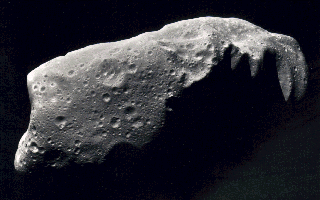
Note: Click on Solar System Exploration: Galileo Legacy Site (NASA-JPL) to get this image at its highest resolution.
Asteroid 243 Ida appears in this mosaic of 5 images to be about 56 kilometers (35 miles) in length,
irregularly-shaped with numerous craters on its surface.
It is a member of the Koronis family of asteroids.
August 28, 1993. Ranges, 3,057 to 3,821 kilometers (1,900 to 2,375 miles).
The smallest objects visible in the image are 70 meters (230 feet) across.
This view of Ida was taken about 3-1/2 minutes before the spacecraft made
its closest approach to the asteroid, when Galileo flew within 2,400
kilometers (1,500 miles) from Ida at a relative velocity of 12.4 km/sec (28,000 mph) at 9:52:05 PDT.
Asteroid and spacecraft were 441 million kilometers (274 million miles) from the Sun.
The camera's clear filter was used to produce this extremely sharp picture.
Ida is the second asteroid ever encountered by a spacecraft.
It is more than twice as large as Gaspra, the first asteroid observed by Galileo in October 1991.
Ida is an irregularly shaped asteroid placed by scientists in the S class
(believed to be like stony or stony- iron meteorites).
It is a member of the Koronis family, presumed fragments left from the
breakup of a larger asteroid in a catastrophic collision.
As the Koronis family is still closely grouped, scientists initially assumed
that Ida had to be a relatively young asteroid, with a "youthful" surface.
This view shows numerous craters, including many degraded craters larger
than any seen on Gaspra. The extensive cratering seems to dispel theories
about Ida's surface being geologically youthful (in which case there would
have been relatively few craters).
This view also seems to rule out the idea that Ida is a double body.
The south pole is in the dark side of this image near the middle of the asteroid.
NASA policy requires that all missions which pass through the asteroid belt
between Mars and Jupiter consider a close observation of an asteroid if at
all possible.
So, Galileo's Mission Designers checked out more than 4,000 asteroid orbits,
looking for flyby candidates that would be compatible with Galileo's VEEGA
(Venus-Earth-Earth-Gravity Assist) trajectory.
The leading contenders were then more closely examined with trajectory optimization software to determine which would be the best target, much like the process of planning interesting detours on a long driving trip while staying within budget and not exceeding total vacation time.
In the end, Gaspra and Ida were chosen based on their accessibility,
specially their low propellant cost (from the short detour that Galileo
would be required to take to see them).
This double asteroid option resulted in the scientific benefit of Galileo
visiting two very different S-type asteroids.
Next slide: Ida's Limb
Back: Galileo To Jupiter
Link to: Solar System Exploration: Galileo Legacy Site (NASA - JPL)
Updated: October 28 '96
Best seen with MS Internet Explorer.
Back: ARVAL - Image Gallery
Messages: